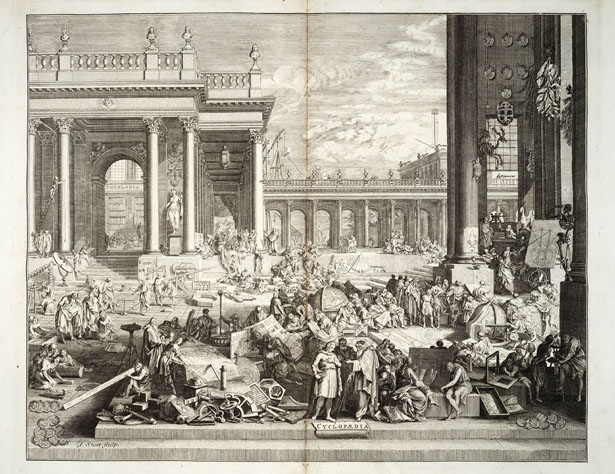What If the Great Wikipedia 'Revolution' Was Actually a Reversion?
Sure, Wikipedia represents a drastic departure from the Encyclopaedia Britannica, but if you compare it with even earlier reference works, it doesn't look so unusual.
Wikipedia certainly deserves many of the superlatives ascribed to it: It is unquestionably the largest, deepest, and most accessible encyclopedia ever written.
But a new paper argues that when it comes to the method by which Wikipedia was assembled -- amateur, obsessive collaborators augmenting earlier work bit by bit -- Wikipedia's not as revolutionary as it's cracked up to be.
"Wikipedia has been repeatedly compared with just one other encyclopedia, the Encyclopaedia Britannica in its most recent printed and electronic editions," Jeff Loveland and Joseph Reagle write. But what if its the latter years of the EB -- and not Wikipedia -- that's historically unusual?
Take your standard Wikipedian, for example. A Wikipedian is a rare creature whose natural habitat of a dark room lit by their Macbook Air and an old Ikea lamp emerged only in the last decade or so. These wild beings spend their days and nights obsessively editing the encyclopedia, arguing about its finer points in its back pages, racking up their "edit counts."
But just because their habitats have changed and their numbers proliferated, doesn't mean they are an entirely new species. Rather, "obsessive compilers," as Loveland and Reacle call them, have been around for a long time -- at least since Pliny the Elder wrote his 37-volume Natural History in ancient Rome. Over the centuries, obsessive compilers have been behind not just encyclopedias, but dictionaries, medical texts, histories, and even object collections, such as herbaria. Loveland, of the University of Cincinnati, and Reagle, of Northeastern, point to examples such as Louis de Jaucourt, who wrote some 25 percent of Denis Diderot and Jean Le Ron D'Alembert's Encyclopedie and James Tytler, who assembled the second edition of the Encyclopaedia Britannica. Today's Wikipedians may have less visibility than the compilers of the past, but they are motivated by the same compulsive urge to collect knowledge and organize it.
Another similarity between encyclopedias of old and Wikipedia: the process of building upon existing work bit by bit, or what the authors call "stigmergic accumulation." Now, that's a mouthful, but it's also a great metaphor. "Stigmergy," they write, describes "how wasps and termites collectively build complex structures by adding to the product of previous work rather than by communicating directly among themselves."
We tend to think of older encyclopedias as independent works, created by their authors and editors afresh in pursuit of greater depth and accuracy. Not quite, the authors explain. In a time before copyright protections, reference works were rife with "borrowing." Scottish "pirates" reprinted Ephraim Chambers' 1728 Cyclopaedia in its entirety, which itself borrowed heavily from the Dictionnaire de Trevoux. "Indeed," Loveland and Reagle write, "Chambers avowed that the Cyclopaedia contained 'little ... new, and of my own growth." Men like Chambers were always a bit author, a bit compiler, a bit borrower, a bit editor. If Wikipedia complicates the notion of "authorship," it's not as though that notion were ever simple to begin with.
Even Wikipedia's open ideology has antecedents during this period. Diderot announced that people were free to reuse the art from his Encyclopedie -- "a stance," the authors note, "probably meant to justify his and his colleagues' appropriation of illustrations from the 'Description des arts et metiers.'"
Perhaps most of all, the originality of Wikipedia's collaborative approach is suspect. Massive works of reference almost by their nature require the input of many people. Diderot's and D'Alembert's Encyclopedie had around 140 different specialists make contributions. The Oxford English Dictionary is famous for its collaborative process, to which thousands of people contributed slips of paper noting the appearance and context of unusual words.
All of this is not to say that Wikipedia represents nothing new. Certainly its size and the fact that millions upon millions of people have access to and actually use it make it unlike anything the world has ever seen before, and I don't want to downplay those accomplishments. But it's hard to discern what is genuinely new about Wikipedia and what falls in line with historical patterns if you only compare it to the Encyclopaedia Britannica. Instead, when you place Wikipedia in a longer timeframe, it seems that the historical anomaly was not today's online collaboration, but the 20th century's professionalized, bureaucratically produced tomes.
In fact, this seems to be true of so many of the Internet's "innovations": Blogs look like 18th- and 19th-century publishers more than they do The New York Times or The Washington Post; small crafters selling their wares on Etsy look more like earlier markets than the 20th century's big chains. We have a tendency to reach for the most recent historical examples as our benchmarks, but when you take a longer view, you see that we haven't so much as broken with the past as repeated it.
